
Uroplatus phantasticus, the satanic leaf-tailed gecko, eyelash leaf-tailed gecko or the phantastic leaf-tailed gecko, is a species of gecko indigenous to the island of Madagascar. First described in 1888 by George Albert Boulenger, U. phantasticus is the smallest in body of the Uroplatus geckos, though there is an ongoing debate as to whether one of its cousins, U. ebenaui, is smaller because of its shorter tail.

Ikakogi tayrona, or the Magdalena giant glass frog, is a species of frog in the family Centrolenidae. It is endemic to the Sierra Nevada de Santa Marta, Magdalena Department, Colombia. It is the only glass frog that is known to show maternal care.

Nymphargus anomalus is a species of frog in the family Centrolenidae. It is endemic to Ecuador and occurs on the Amazonian slopes of the Ecuadorian Andes in the Napo Province. Common name Napo Cochran frog has been coined for it.
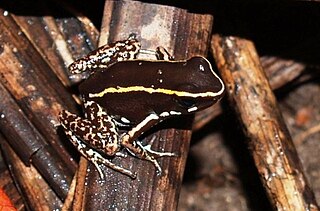
The lovely poison frog or lovely poison-arrow frog is a species of frog in the family Dendrobatidae. It is found on the Caribbean versant of Central America from southeastern Nicaragua through Costa Rica to northwestern Panama, with one record just west of the Panama Canal. Populations from the Pacific versant, formerly included in this species, are now identified as Phyllobates vittatus.
Sarcohyla sabrina, also known as the Sierra Juarez treefrog, is a species of frog in the family Hylidae. It is endemic to the northern slopes of Sierra de Juárez in northern Oaxaca, Mexico. The specific name sabrina is Latin for river nymph and refers to the close association of this species with streams.
Leptopelis fiziensis, also known as the Mokanga forest tree frog or Fizi tree frog, is a species of frog in the family Arthroleptidae. It is known from the Democratic Republic of the Congo and Tanzania, on both sides of Lake Tanganyika, and it is likely to occur in Burundi, in between the two know areas of distribution.

Leptopelis flavomaculatus is a species of frog in the family Arthroleptidae. It is found in the lowlands eastern and southern Africa, from Mozambique north of the Save River and Zimbabwe to Malawi, eastern Tanzania, and coastal Kenya. Its common names are yellow-spotted tree frog, brown-backed tree frog, brown forest treefrog, and Johnston's treefrog.

Leptopelis macrotis, sometimes called the big-eyed forest tree frog, is a species of frog in the family Arthroleptidae. It is found in the rainforests of Sierra Leone, southern Guinea, Liberia, Ivory Coast, and southern Ghana. Notice that similar common name "big-eyed tree frog" is sometimes used for Leptopelis vermiculatus from Tanzania and for Litoria exophthalmia from New Guinea.
The Tai forest tree frog, Leptopelis occidentalis, is a species of frog in the family Arthroleptidae. It is found in Liberia, southern Ivory Coast, and Ghana. Records from Nigeria are controversial and may refer to other species, possibly Leptopelis boulengeri.
Craugastor fleischmanni is a species of frog in the family Craugastoridae. It is endemic to Costa Rica where it has been found on the Meseta Central Oriental and Occidental, the Pacific slopes of the Barva and Poás Volcanos, the Atlantic slopes of the Irazú and Turrialba Volcanos, and on the Cordillera de Talamanca. Common name Fleischmann's robber frog has been suggested for this species.
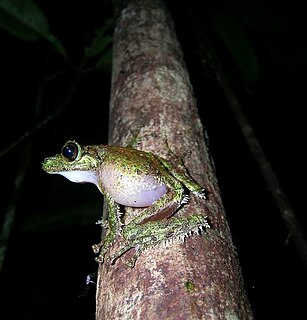
Spinomantis aglavei is a species of frog in the mantellid subfamily Mantellinae, endemic to Madagascar.
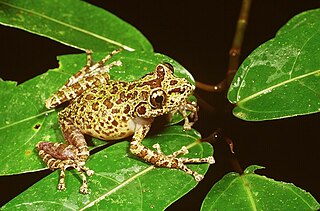
Spinomantis peraccae is a species of frog in the mantellid subfamily Mantellinae. It is endemic to Madagascar and widely distributed in the northern, eastern, and central parts of the island. The specific epithet honours Italian herpetologist Mario Giacinto Peracca. Common name Peracca's Madagascar frog has been coined for it.

Petropedetes cameronensis, sometimes known as the Cameroon water frog, is a species of frog in the family Petropedetidae. It is found in southeastern Nigeria, southwestern Cameroon, and on the island of Bioko. It is the type species of the genus Petropedetes.

Spinomantis is a frog genus in the mantellid subfamily Mantellinae. This genus is restricted to Madagascar. At present it contains 13 species. They are arboreal or terrestrial frogs and occur in or along small streams. Most species are nocturnal.
Papurana volkerjane is a species of true frogs, family Ranidae. It is endemic to New Guinea and is known from its type locality, the eastern slopes of the Wondiwoi Mountains, from the Fakfak Mountains, and from the Bewani and Torricelli Mountainss in the West Sepik Province, Papua New Guinea. Rainer Günther named the species after his son Volker and daughter-in-law Jane.
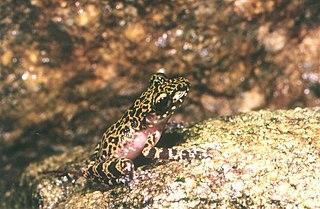
Spinomantis brunae is a species of frogs in the family Mantellidae. It is endemic to Madagascar and known from the Anosy Mountains in southeastern Madagascar.
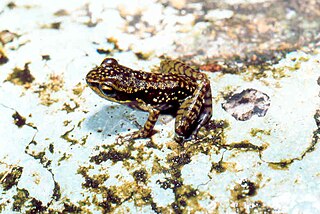
Spinomantis bertini is a species of frog in the mantellid subfamily Mantellinae, endemic to Madagascar.

Spinomantis elegans is a species of frog in the Mantellid subfamily Mantellinae, endemic to Madagascar.

Spinomantis massi is a species of frog in the mantellid subfamily Mantellinae. It is endemic to the humid forests of northwestern Madagascar.

Spinomantis tavaratra is a species of frogs in the mantellid subfamily Mantellinae. It is endemic to the humid forests of northwestern Madagascar.















